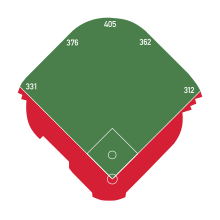King County Stadium | |
 | |
 Exterior of the Kingdome from the north parking lot in 1996 | |
 | |
| Full name | King County Stadium |
|---|---|
| Address | 201 South King Street |
| Location | Seattle, Washington, U.S. |
| Coordinates | 47°35′43″N 122°19′53″W / 47.59528°N 122.33139°W |
| Public transit | |
| Parking | ~1,100 spaces |
| Owner | King County |
| Operator | King County Department of Stadium Administration |
| Executive suites | 46 |
| Capacity | Baseball: 59,166 Football: 66,000 Basketball: 40,000  |
| Surface | AstroTurf |
| Scoreboard | Diamond Vision |
| Construction | |
| Broke ground | November 2, 1972 |
| Opened | March 27, 1976 |
| Closed | January 9, 2000 |
| Demolished | March 26, 2000 |
| Construction cost | $67 million ($359 million in 2023 dollars[1]) |
| Architect | Naramore, Skilling & Praeger |
| Structural engineer | Skilling, Helle, Christiansen & Robertson, Inc.[2] |
| General contractor | Donald M. Drake Company (1972–74) Peter Kiewit Sons Construction Company (1974–76)[3] |
| Tenants | |
| Seattle Seahawks (NFL) (1976–1999) Seattle Sounders (NASL) (1976–1983) Seattle Mariners (MLB) (1977–1999) Seattle SuperSonics (NBA) (1978–1985) | |

The Kingdome (officially the King County Stadium)[4][note 1] was a multi-purpose stadium located in the Industrial District (later SoDo)[7] neighborhood of Seattle, Washington, United States. Owned and operated by King County, it was best known as the home stadium of the Seattle Seahawks of the National Football League (NFL) and the Seattle Mariners of Major League Baseball (MLB); it was also home to the Seattle SuperSonics of the National Basketball Association (NBA) (from 1978 to 1985) and additionally served as both the home outdoor and indoor venue for the Seattle Sounders of the North American Soccer League (NASL). The Kingdome measured 660 feet (200 m) wide from its inside walls.[8]
The idea of constructing a covered stadium for a major league football or baseball team was first proposed to Seattle officials in 1959. Voters rejected separate measures to approve public funding for such a stadium in 1960 and 1966, but the outcome was different in 1968; King County voters approved the issue of $40 million in municipal bonds to construct the stadium. Construction began in 1972 and the stadium opened in 1976 as the home of the Sounders and Seahawks.[9] The Mariners moved in the following year, and the SuperSonics moved in the year after that, only to move back to the Seattle Center Coliseum in 1985. The stadium hosted several major sports events, including the Soccer Bowl in August 1976, the Pro Bowl in January 1977, the Major League Baseball All-Star Game in July 1979, the NBA All-Star Game in 1987, and the NCAA Final Four in 1984, 1989, and 1995.
During the 1990s, the Seahawks' and Mariners' respective ownership groups began to question the suitability of the Kingdome as a venue for each team, threatening to relocate unless new, publicly funded stadiums were built. An issue was that neither team saw their shared tenancy as profitable; both teams also questioned the integrity of the stadium's roof as highlighted by the collapse of ceiling tiles onto the seating area before a scheduled Mariners game in 1994. As a result, public funding packages for new, purpose-built stadiums for the Mariners and Seahawks were respectively approved in 1995 and 1997.
The Mariners moved to Safeco Field, now known as T-Mobile Park, midway through the 1999 season, and the Seahawks temporarily moved to Husky Stadium after the 1999 season. On March 26, 2000, the Kingdome was demolished by implosion. The Seahawks' new stadium, now known as Lumen Field, was built on the site and opened in 2002. King County finally paid off the bonds used to build and repair the Kingdome in 2015, fifteen years after its demolition.[10]
- ^ 1634–1699: McCusker, J. J. (1997). How Much Is That in Real Money? A Historical Price Index for Use as a Deflator of Money Values in the Economy of the United States: Addenda et Corrigenda (PDF). American Antiquarian Society. 1700–1799: McCusker, J. J. (1992). How Much Is That in Real Money? A Historical Price Index for Use as a Deflator of Money Values in the Economy of the United States (PDF). American Antiquarian Society. 1800–present: Federal Reserve Bank of Minneapolis. "Consumer Price Index (estimate) 1800–". Retrieved February 29, 2024.
- ^ "King County, Department of Stadium Administration, Domed Stadium, Pioneer Square, Seattle, WA". Pacific Coast Architecture Database. University of Washington. Retrieved October 28, 2012.
- ^ Ledbetter, Les (December 5, 1977). "Seattle Stadium Suit a Legal Test on Cost Overruns". The New York Times. p. 18. Retrieved February 24, 2021.
- ^ AN ORDINANCE relating to the multi-purpose public stadium specified in King County Resolution No. 34567; providing a name therefore (PDF) (Ordinance 2483). King County Council. August 25, 1975.
- ^ Name (Section 4, King County Code Title 22 (Stadium)). King County Council. March 26, 2012.
- ^ Macintosh, Heather (January 1, 2001). "Kingdome opens to a crowd of 54,000 on March 27, 1976". HistoryLink. Retrieved April 3, 2010.
- ^ Upchurch, Michael (July 22, 2010). "Seattle's slightly amphibious Sodo subject of new photo-history". The Seattle Times. Retrieved March 17, 2021.
- ^ "24 years of Kingdome facts & figures". King County. March 27, 2000. Archived from the original on March 3, 2016.
{{cite web}}: CS1 maint: unfit URL (link) - ^ Baker, Tony (December 10, 1976). "Seattle's own Cardiac Hill?". Lewiston Morning Tribune. Associated Press. p. 3B.
- ^ Baker, Geoff (March 26, 2015). "Kingdome debt to be retired 15 years after implosion". The Seattle Times. Archived from the original on September 24, 2015. Retrieved July 11, 2015.
Cite error: There are <ref group=note> tags on this page, but the references will not show without a {{reflist|group=note}} template (see the help page).